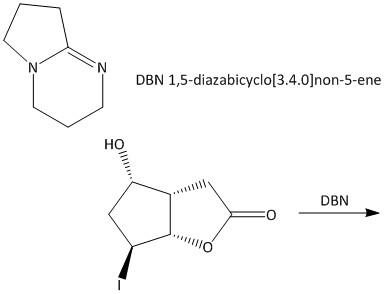Answer
405k+ views
Hint: \[DBN\]is a fused bicyclic compound formed by the fusion of a five and a six membered ring. This compound acts as an organic base in organic synthesis.
Complete step by step answer:
\[DBN\] is an organic compound with chemical formula \ [{C_7}{H_{12}}{N_2}\]. It is an amidine base and is often used for abstracting protons from compounds. The anion produced takes part in several reactions like elimination, substitution, addition and rearrangement reactions.
The given reaction is an example of elimination reaction. The reaction begins by abstracting the proton by the base. The anion produced takes part in an elimination reaction by removal of the iodo group. The iodo group is a very good leaving group.
Iodine is an element in the periodic table with atomic number\[53\]. Its electronic configuration is $I:[Kr]4{d^{10}}5{s^2}5{p^5}$
The iodine has vacant \[p\]-orbital and can place an electron in the orbital. Iodine also has inner \[4f\] orbitals in which it can accommodate an extra pair of electrons. The mechanism for the elimination reaction is written as:

The endocyclic double bond is formed by the elimination of iodo groups. The reaction produces two \[s{p^2}\] hybridized carbon atoms from \[s{p^3}\] hybridized carbon atom. The reaction follows \[E1cb\](\[cb\] = conjugate base) mechanism in which the first step is the rate determining step, i.e. anion formation. The first step is reversible in nature. The second step is a slow step.
So, the correct answer is Option A.
Note: The reaction is also done using other bases like \[DBU\] or triethylamine or\[DIPEA\]. All these are organic bases and help in abstraction of protons and thereby resulting in an elimination reaction.
Complete step by step answer:
\[DBN\] is an organic compound with chemical formula \ [{C_7}{H_{12}}{N_2}\]. It is an amidine base and is often used for abstracting protons from compounds. The anion produced takes part in several reactions like elimination, substitution, addition and rearrangement reactions.
The given reaction is an example of elimination reaction. The reaction begins by abstracting the proton by the base. The anion produced takes part in an elimination reaction by removal of the iodo group. The iodo group is a very good leaving group.
Iodine is an element in the periodic table with atomic number\[53\]. Its electronic configuration is $I:[Kr]4{d^{10}}5{s^2}5{p^5}$
The iodine has vacant \[p\]-orbital and can place an electron in the orbital. Iodine also has inner \[4f\] orbitals in which it can accommodate an extra pair of electrons. The mechanism for the elimination reaction is written as:

The endocyclic double bond is formed by the elimination of iodo groups. The reaction produces two \[s{p^2}\] hybridized carbon atoms from \[s{p^3}\] hybridized carbon atom. The reaction follows \[E1cb\](\[cb\] = conjugate base) mechanism in which the first step is the rate determining step, i.e. anion formation. The first step is reversible in nature. The second step is a slow step.
So, the correct answer is Option A.
Note: The reaction is also done using other bases like \[DBU\] or triethylamine or\[DIPEA\]. All these are organic bases and help in abstraction of protons and thereby resulting in an elimination reaction.
Recently Updated Pages
How many sigma and pi bonds are present in HCequiv class 11 chemistry CBSE

Why Are Noble Gases NonReactive class 11 chemistry CBSE

Let X and Y be the sets of all positive divisors of class 11 maths CBSE

Let x and y be 2 real numbers which satisfy the equations class 11 maths CBSE

Let x 4log 2sqrt 9k 1 + 7 and y dfrac132log 2sqrt5 class 11 maths CBSE

Let x22ax+b20 and x22bx+a20 be two equations Then the class 11 maths CBSE

Trending doubts
Fill the blanks with the suitable prepositions 1 The class 9 english CBSE

Which are the Top 10 Largest Countries of the World?

Write a letter to the principal requesting him to grant class 10 english CBSE

Difference between Prokaryotic cell and Eukaryotic class 11 biology CBSE

Give 10 examples for herbs , shrubs , climbers , creepers

Fill in the blanks A 1 lakh ten thousand B 1 million class 9 maths CBSE

Change the following sentences into negative and interrogative class 10 english CBSE

Difference Between Plant Cell and Animal Cell

Differentiate between homogeneous and heterogeneous class 12 chemistry CBSE







